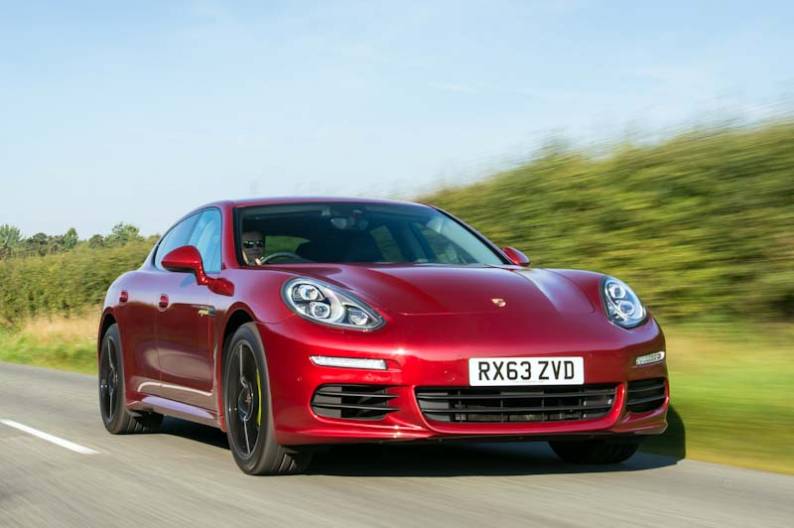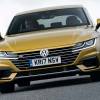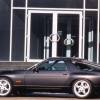
RAC sale – up to 33% off*
• Roadside cover from £5.29 a month†
• We get to most breakdowns in 60 mins or less
• Our patrols fix 4/5 breakdowns on the spot

By Jonathan Crouch
Introduction
Named after the Carrera Panamerican road race, Porsche's Panamera is the brand's offering to Luxury segment buyers wanting spacious rear seat accommodation and a properly sporting Gran Turismo driving experience. This model could have ended up being a four-door version of the company's 911 coupe or a low-slung interpretation of the marque's Cayenne luxury SUV. In the event, it's very much its own car, a long, low five-door hatchback that offers something very different in its sector. In this improved post-2013 first generation guise, it was smarter, faster, more efficient and, in E-Hybrid form, impressively advanced too. For boardroom buyers who yearn for Brands Hatch, it's a tempting used car proposition.
Models
5dr saloon (3.0 hybrid, 3.6, 4.8 petrol, 3.0 turbodiesel [S, 4S, GTS, Turbo, Turbo S])
History
Is there really such a thing as a four-seater sportscar? Porsche thinks so. This Panamera is the model that company founder Ferdinand Porsche always dreamed of making, something that would be more than simply another powerfully performing Luxury segment saloon. A machine instead created around the uncompromising sportscar principles that so characterise its brand - and a design that the Stuttgart brand tried to redefine in the improved post-2013 first generation model we're going to look at here as a potential used car buy.
To understand the Panamera, you have to understand the way that Porsche sees it. This car may be priced against Mercedes S-Class-style Luxury saloons but its role in life is subtly different. The brand calls it a 'Gran Turismo', the kind of car that allows two rear seat passengers to recline in comfort while the driver enjoys himself. Forget Audi A8s and Jaguar XJs. Think instead Maserati Quattroporte or even Aston Martin Rapide. In other words, a four-door luxury conveyance to really get the pulses racing. This car won't be chauffeur-driven.
Or at least it won't be here. Back in 2013, the addition of a long wheelbase bodystyle was one of the ways that Porsche improved this model's proposition for other markets but for ours, the importers always focused on efficient technology in the round of updates that created the subtly different improved MK1 model we look in this review. Byers got a cleaner, more effective 3.0-litre biturbo V6 for the mainstream petrol-powered Panamera S that such a large proportion of them chose. Plus an uprated 300bhp version of the strongest-selling diesel variant. And, perhaps most notably, there was the E-Hybrid variant, this legendary German maker's first plug-in petrol/electric hybrid and a car capable of both super-clean emissions and supercar performance. It all added up to a Porsche that on paper, seemed to boast a formidable array of talents. This model sold until the all-new second generation Panamera was launched in late 2016.
What You Get
Shut your eyes, picture what a four-door Porsche 911 sports coupe might look like and you won't be a million miles away from the reality of this Panamera. It's an unusual look that won't be to everyone's taste, but the low, lean shape certainly does grow on you. The raised profile of the front wings is of course a brand trademark, but it can't in this case be matched by the kind of flat bonnet you'd get in one of the company's sportscars because here of course, the engine must be in the front, hence the power bulge. As ever, this model takes Luxury saloon segment conventionality and puts it through the paper shreader. Cars of this kind aren't supposed to be hatchbacks, nor are they supposed to only offer four seats. This one though, thinks differently, just as Porsche hopes its buyers will.
These people will certainly be folk who liked the original version of this car, for this revised first generation model looks hardly any different - at least at first glance. Peer a little closer though and the differences become clearer. At the front, there are larger air intakes that are even bigger on the V8 models, as well as smarter bumpers and sleeker bi-xenon headlamps with LED daytime running lights.
Move to the side and owners of the original MK1 design might note the more swept-back windscreen that extends the silhouette, the sharper profile lines and larger glass area. Asian markets got a long wheelbase bodyshape but Porsche never thought there'd be enough take-up for it here. As usual, colour-contrasting brake callipers give away the nature of the engine beating beneath the sculpted bonnet.
At the rear, Porsche aimed for a lower stance and a wider look by widening the rear screen, increasing the size of the LED light clusters and lowering the number plate to a position just above the level of the model-specific tailpipes. As with the original model, the detailing is superb: take the way the wider rear spoiler opens upwards and outwards in two parts - a beautiful touch.
And inside? Well if you think that the exterior changes made to his post-2013 model are difficult to spot, you'll find it even harder to notice any of the updates made to the driver-centric cockpit. Which mean that if you're used to the original version of this design, you'll be provided with more of the same - a Porsche sportscar that also happens to be a super-luxury saloon. Which means that, as before, the low-slung seating layout with its perfect positioning and almost infinite adjustability really is quite similar to a 911's, while the tall centre console that runs down the middle of the cabin hems you comfortably in, fighter aircraft cockpit-style.
It extends right to the back of the car, firmly defining this car as a four-seater and enabling the designers to create purpose-built sports chairs at the back rather than an indented bench upon which at higher cornering speeds, occupants would be quickly rolling about. Back here, these aren't the compromised pews you'd expect to find in something professing to be a four-door sportscar, instead offering standards of head and legroom not really that far off Mercedes S-Class or a BMW 7 Series saloons. The seats are even positioned a little more centrally than those ahead, so you get a decent view of the action going on up-front.
As for luggage space, well if, like us, you're tempted to approach this car expecting that its hatchback configuration will mean a bigger boot, you'll be disappointed. Click the keyfob button for the standard power-operated tailgate and you'll find that the most you can get is a 445-litre total common to normally aspirated and diesel models, which is about 15% less than you'd usually expect from a rival Luxury segment saloon. But then such a rival Luxury segment saloon wouldn't offer you the flexibility of being able to drop its rear seats and reveal up to 1,263-litres of total luggage capacity - which is what's on offer here. Bear in mind by the way that not all Panamera variants deliver the figures we've quoted. The luggage space figures for the petrol Turbo variants are, for some reason, a fraction down, reduced to 432 and 1,250-litre readings.
As you might expect, the E-Hybrid version really suffers in practicality terms, given that its battery pack is housed beneath the boot floor. Here, you'll have only 335-litres to play with - or 1,153-litres if you flatten the rear seats.
What You Pay
Please fill in the form here for an exact up-to-date information.
What to Look For
Check for parking damage and kerbed alloys and make sure all of the electric functions work. Check for a fully stamped-up service record and do an HPI check to make sure the car you're looking at is legitimate. The hybrid drive system has proven as tough as old boots. Tyres are pricey, so do check that your Panamera isn't in need of new boots. Inconsistently-worn tyres will also hint at alignment issues. Virtually all Panamera models will pass through Official Porsche Centres, so you can normally buy with confidence, albeit without expecting a screaming bargain.
Replacement Parts
(approx based on a 2014 Panamera S 3.0 biturbo V6) An oil filter costs in the £14 to £22 bracket. Brake pads sit in the £75 bracket for a set, though you could pay up to around £140 or even as much as £185 for a pricier brand. Brake discs cost around £195. Wiper blades cost in the £4 to £17 bracket, though you could pay as much as around £30 for a pricier brand. Shock absorbers cost around £270 - or even as much as around £335 for pricier brands.
On the Road
Really clever engineering can defy the laws of physics. If you want proof, this revised first generation Panamera model provides it. Thanks to fantastic steering and an astonishing lack of body roll, on fast, flowing roads - and even on some open tighter ones - this two-tonne luxury saloon feels almost as agile as a Porsche 911. Or at least it does when specified with all of the brand's expensive dynamic options. Only when threading the car through town does its prodigious width remind you how huge it actually is. And of course, more powerful versions can be ballistically fast, capable of generating G Forces denied to just about any other car we can think of from this era featuring four luxurious seats.
As for the dynamic changes made to this revised first generation Panamera, well at first glance, you might think that there aren't many - until you come to look at the engine choice on offer. Two completely fresh powerplants were added to the Panamera line-up at this revised model's launch in 2013. One of them is well worth seeking out - the 420bhp 3.0-litre V6 biturbo fitted to the mainstream Panamera S model. Its 420bhp output offers a useful advantage over an entry-level variant badged simply 'Panamera' which offers a 310bhp 3.6-litre V6 capable of 62mph from rest in 6.3s en route to 160mph. Go for that preferrable biturbo engine in the Panamera S though and you'll improve those readings to 5.1s and 178mph. Even better - and more importantly - pulling power rises from 400 to 520Nm, so the real world performance gain will feel greater than those figures suggest, an impression further heightened by Porsche's clever sound symposer technology that releases a sonorous roar under hard acceleration.
Whichever of these two mainstream petrol variants you decide upon, there's the option of the 4WD system you won't want to be without after using it through a typical European winter. It's a set-up that's standard further up the petrol range to handle the much greater power available from the more potent 4.8-litre V8 petrol models that continued on in this revised model from the previous line-up. The first of these, the normally aspirated GTS version, puts out 440bhp (10bhp more than before), good enough to see you to 62mph in just 4.4s en route to 179mph. To be honest, it's hard to image why you'd need to go any faster than that in a car of this kind but should you desire to, then the two Turbo models await. The standard Turbo offers 520bhp (20bhp up on before) and trims the performance stats to 4.1s and 189mph, while the top Turbo S ups the ante to 570bhp, delivering 3.8s and 192mph. All the conventional petrol models we've just mentioned - 3.6, 3.0-litre biturbo and 4.8 - use the same seven-speed PDK twin-clutch auto gearbox, which was tweaked in this revised model with extra 'virtual' intermediate ratios supposed to improve fuel economy and comfort. By 2013, Panamera buyers were no longer offered a manual gearbox option (even Porsche had to give up on that), but they could have tactile metal paddleshifters behind the steering wheel.
You'll find that the auto transmission technology changes though, if your interest falls upon the two more sensible Diesel and Hybrid Panamera models. These use an older-tech Tiptronic S set-up that, with eight speeds, is easier to combine with the kind of efficiency initiatives likely buyers will be seeking. Let's start with the Diesel, since it accounted for over 65% of Panamera sales. It still uses a 3.0-litre six cylinder engine borrowed from Audi but with the post-2013-era mdel, it was a unit a little better suited to propelling nearly two tonnes of German luxury real estate towards the horizon. Power rose from 250 to 300bhp, enough to deliver an appropriately rapid set of stats - 62mph from rest in 6 secs dead en route to 160mph.
All of which brings us to the most eco-minded variant, the cleverest in the line-up and the one upon which the majority of this model's redevelopment budget was spent - the Panamera S E-Hybrid. Back in 2013, this model was crucial for the Porsche brand, not only because of the interest in Hybrid power in Porsche's core US and Chinese markets but also because of the lack of a really powerful conventional diesel alternative in a range that really needed it. Given that the 4.2-litre V8 TDI unit the company used in its Cayenne SUV from this era wouldn't fit beneath the bonnet of a first generation Panamera, buyers in this model range seeking high performance with high frugality really needed another option - and this was it.
Much then, depended on the petrol/electric Hybrid variant, a 2WD model using much of the hi-tech cleverness developed for Porsche's 918 Spyder hypercar. Primarily, that means Plug-in technology, so owners could charge this car from the mains. Plus the previous Panamera S Hybrid model's ancient nickel metal hydride battery was, with the S E-Hybrid, replaced with a hi-tech lithium-ion unit with over five times the storage capacity. That meant owners of this improved plug-in derivative could expect a decent electric-only operating range: to be specific, somewhere between 11 and 22 miles, depending on speed and conditions - which was quite a step forward given that the original version wouldn't go much more than a mile or so before its engine cut in.
But the petrol/electric Plug-in Panamera doesn't only focus on frugality. Its battery boosts performance too, aided by a 95bhp electric motor that's over twice as powerful as that of the old 'S Hybrid' model. What wasn't changed was the 333bhp Audi-sourced 3.0-litre supercharged V6 petrol engine it was paired with, the two working together to create a combined system power output of 416bhp, accessed via four selectable operating modes - E-Power, Hybrid, E-Charge and Sport. Unless the temperature's below freezing or you've forgotten to charge the car up, you'll always be starting off in electric-only 'E-Power', in which near-silent guise the car is capable of an impressive maximum speed of as much as 84mph. When the battery range is used up or you need to use the kickdown for rapid acceleration, the car will automatically switch to petrol/electric 'Hybrid' mode, a setting you might also want to switch to early if, for example, you want to save the battery charge for some city driving later on in your trip. Mind you, that may not be necessary thanks to the clever 'E-Charge' option which can charge that battery as you drive. Finally, there's the 'Sport' mode which harnesses the power of the petrol engine with the full boost of the electric motor to spirit this two-tonne luxury sports Gran Turismo to 62mph in just 5.5s en route to 168mph.
Enough with what lies beneath the bonnet: we need to talk more about the driving experience. This was always intended to be a more dynamic choice in the Luxury segment, a four-door sportscar that happened to be able to seat a quartet of passengers in comfort. Porsche's perspective was that if that was the case, it was hardly reasonable for buyers to expect it to ride like a Rolls Royce. Behind the scenes though, their engineers put a lot of work into getting the ride of this car a little closer to customer expectations in this sector. Hence a range of suspension tweaks which meant that this Panamera's ride at low speed over poor surfaces proved to be significantly better than it was before.
This may well be the first thing you'll notice when getting behind the wheel of a post-2013 first generation Panamera, particularly if you come to it familiar with the previous version. When it comes to ride quality, the S E-Hybrid model starts out with an advantage in the standard fitment of the clever Adaptive air suspension system that was optional on lesser Panamera variants. This automatically keeps the vehicle level constant, regardless of the load distribution. Plus there's a manual lift function enabling you to raise the body by 20mm to reduce the risk of grounding. The system works in conjunction with the PASM (Porsche Active Suspension Management) electronic damping control system that offers 'normal', 'Sport' and 'Sport Plus' settings to vary the ride from cosseting to clinically precise. The driver-orientated 'Sport Plus' setting is even cleverer if you've the air suspension fitted: select this mode and the ride height automatically drops by 25mm and the springs harden.
If that's something you're likely to be activating very often, then there are three other options you really need to be looking for. The first is a feature almost all original Panamera buyers chose - the Sport Chrono Package that gives even sportier tuning of the engine and chassis set-up. When fitted with the PDK gearbox, it quickens its shift times and offers F1-style Launch Control for quick getaways. Some original owners also added PDCC 'Porsche Dynamic Chassis Control' to limit cornering roll and got themselves an electronically regulated rear differential lock for extra rear wheel traction. Further cornering vim can be encouraged by a Porsche Torque Vectoring Plus system that works through the twisty stuff to counter both understeer and wheelspin by lightly micro-braking whichever front wheel is threatening to lose grip. As a result, the car's kept planted through the tightest turn and you're fired on from bend to bend. It's the Panamera way.
Overall
Creating a fast luxury saloon is about a lot more than just equipping it with a powerful engine. Yet before the Panamera arrived, that was all buyers in this sector were ever really offered. If you want to go very fast, very comfortably in a straight line, that may be all very well but for those boardroom buyers who don't spend all their lives wafting up and down autobahns, the Panamera is still in a class of its own.
True, engine changes apart, this improved first generation model didn't really offer buyers very much that was new - but then it was precisely in the engine department that this car really needed to step up a gear. The original version offered an under-performing diesel, a thirsty mainstream petrol option and an irrelevant Hybrid variant. The 300bhp diesel, 3.0-litre biturbo petrol V6 and Plug-in Hybrid technology that characterised this improved post-2013-era Panamera model line-up changed all of that.
It may not be quite as cosseting as some of its limousine-like rivals from this era, but they wouldn't see which way this car went on a twisty road. Nor are they as practical for day-to-day use. Overall, if you still enjoy driving and like the way it looks, you'll love the way it rewards you at the wheel. The Panamera's unconventional. It's unique. But best of all, it's a proper Porsche.




![Audi A8 [D4] (2013 - 2017) used car review](https://d1ix0byejyn2u7.cloudfront.net/drive/images/made/drive/images/remote/https_d2yv47kjv2gmpz.cloudfront.net/filestore/3/0/0/3_be0cf15d2fb7d11/a7b6c0cbe7b3f6646fae670b4c197bdd/3003pre_86909ce0277261f_100_100_70_c1_c_c.jpg)


